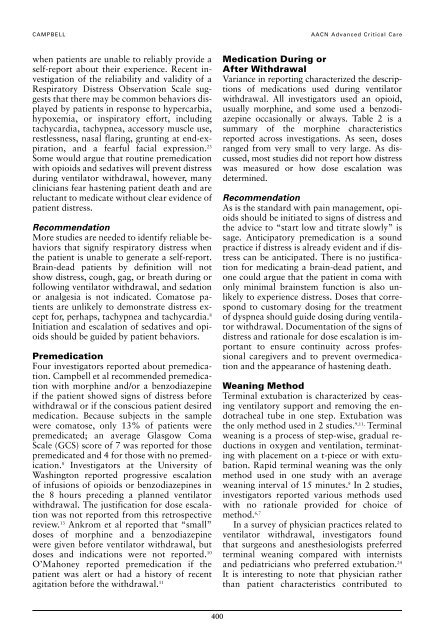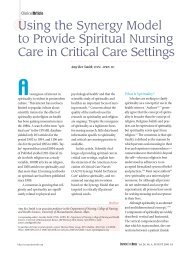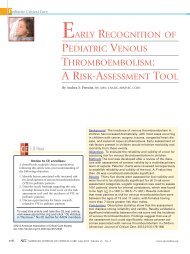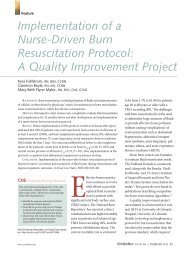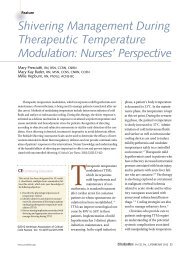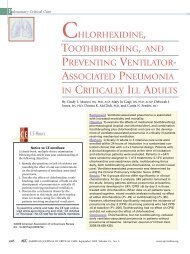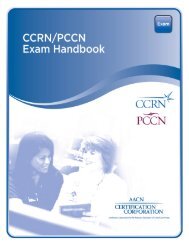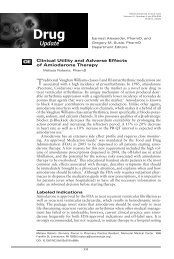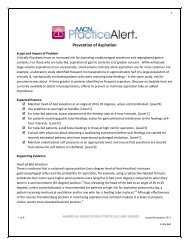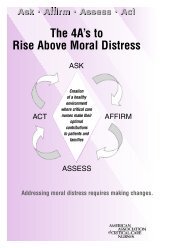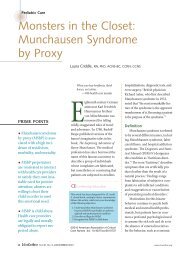How to Withdraw Mechanical Ventilation - American Association of ...
How to Withdraw Mechanical Ventilation - American Association of ...
How to Withdraw Mechanical Ventilation - American Association of ...
You also want an ePaper? Increase the reach of your titles
YUMPU automatically turns print PDFs into web optimized ePapers that Google loves.
AACN18_4_397-403 10/20/07 14:23 Page 400<br />
CAMPBELL AACN Advanced Critical Care<br />
when patients are unable <strong>to</strong> reliably provide a<br />
self-report about their experience. Recent investigation<br />
<strong>of</strong> the reliability and validity <strong>of</strong> a<br />
Respira<strong>to</strong>ry Distress Observation Scale suggests<br />
that there may be common behaviors displayed<br />
by patients in response <strong>to</strong> hypercarbia,<br />
hypoxemia, or inspira<strong>to</strong>ry effort, including<br />
tachycardia, tachypnea, accessory muscle use,<br />
restlessness, nasal flaring, grunting at end-expiration,<br />
and a fearful facial expression. 23<br />
Some would argue that routine premedication<br />
with opioids and sedatives will prevent distress<br />
during ventila<strong>to</strong>r withdrawal, however, many<br />
clinicians fear hastening patient death and are<br />
reluctant <strong>to</strong> medicate without clear evidence <strong>of</strong><br />
patient distress.<br />
Recommendation<br />
More studies are needed <strong>to</strong> identify reliable behaviors<br />
that signify respira<strong>to</strong>ry distress when<br />
the patient is unable <strong>to</strong> generate a self-report.<br />
Brain-dead patients by definition will not<br />
show distress, cough, gag, or breath during or<br />
following ventila<strong>to</strong>r withdrawal, and sedation<br />
or analgesia is not indicated. Coma<strong>to</strong>se patients<br />
are unlikely <strong>to</strong> demonstrate distress except<br />
for, perhaps, tachypnea and tachycardia. 8<br />
Initiation and escalation <strong>of</strong> sedatives and opioids<br />
should be guided by patient behaviors.<br />
Premedication<br />
Four investiga<strong>to</strong>rs reported about premedication.<br />
Campbell et al recommended premedication<br />
with morphine and/or a benzodiazepine<br />
if the patient showed signs <strong>of</strong> distress before<br />
withdrawal or if the conscious patient desired<br />
medication. Because subjects in the sample<br />
were coma<strong>to</strong>se, only 13% <strong>of</strong> patients were<br />
premedicated; an average Glasgow Coma<br />
Scale (GCS) score <strong>of</strong> 7 was reported for those<br />
premedicated and 4 for those with no premedication.<br />
8 Investiga<strong>to</strong>rs at the University <strong>of</strong><br />
Washing<strong>to</strong>n reported progressive escalation<br />
<strong>of</strong> infusions <strong>of</strong> opioids or benzodiazepines in<br />
the 8 hours preceding a planned ventila<strong>to</strong>r<br />
withdrawal. The justification for dose escalation<br />
was not reported from this retrospective<br />
review. 13 Ankrom et al reported that “small”<br />
doses <strong>of</strong> morphine and a benzodiazepine<br />
were given before ventila<strong>to</strong>r withdrawal, but<br />
doses and indications were not reported. 10<br />
O’Mahoney reported premedication if the<br />
patient was alert or had a his<strong>to</strong>ry <strong>of</strong> recent<br />
agitation before the withdrawal. 11<br />
400<br />
Medication During or<br />
After <strong>Withdraw</strong>al<br />
Variance in reporting characterized the descriptions<br />
<strong>of</strong> medications used during ventila<strong>to</strong>r<br />
withdrawal. All investiga<strong>to</strong>rs used an opioid,<br />
usually morphine, and some used a benzodiazepine<br />
occasionally or always. Table 2 is a<br />
summary <strong>of</strong> the morphine characteristics<br />
reported across investigations. As seen, doses<br />
ranged from very small <strong>to</strong> very large. As discussed,<br />
most studies did not report how distress<br />
was measured or how dose escalation was<br />
determined.<br />
Recommendation<br />
As is the standard with pain management, opioids<br />
should be initiated <strong>to</strong> signs <strong>of</strong> distress and<br />
the advice <strong>to</strong> “start low and titrate slowly” is<br />
sage. Anticipa<strong>to</strong>ry premedication is a sound<br />
practice if distress is already evident and if distress<br />
can be anticipated. There is no justification<br />
for medicating a brain-dead patient, and<br />
one could argue that the patient in coma with<br />
only minimal brainstem function is also unlikely<br />
<strong>to</strong> experience distress. Doses that correspond<br />
<strong>to</strong> cus<strong>to</strong>mary dosing for the treatment<br />
<strong>of</strong> dyspnea should guide dosing during ventila<strong>to</strong>r<br />
withdrawal. Documentation <strong>of</strong> the signs <strong>of</strong><br />
distress and rationale for dose escalation is important<br />
<strong>to</strong> ensure continuity across pr<strong>of</strong>essional<br />
caregivers and <strong>to</strong> prevent overmedication<br />
and the appearance <strong>of</strong> hastening death.<br />
Weaning Method<br />
Terminal extubation is characterized by ceasing<br />
ventila<strong>to</strong>ry support and removing the endotracheal<br />
tube in one step. Extubation was<br />
the only method used in 2 studies. 9,11, Terminal<br />
weaning is a process <strong>of</strong> step-wise, gradual reductions<br />
in oxygen and ventilation, terminating<br />
with placement on a t-piece or with extubation.<br />
Rapid terminal weaning was the only<br />
method used in one study with an average<br />
weaning interval <strong>of</strong> 15 minutes. 8 In 2 studies,<br />
investiga<strong>to</strong>rs reported various methods used<br />
with no rationale provided for choice <strong>of</strong><br />
method. 6,7<br />
In a survey <strong>of</strong> physician practices related <strong>to</strong><br />
ventila<strong>to</strong>r withdrawal, investiga<strong>to</strong>rs found<br />
that surgeons and anesthesiologists preferred<br />
terminal weaning compared with internists<br />
and pediatricians who preferred extubation. 24<br />
It is interesting <strong>to</strong> note that physician rather<br />
than patient characteristics contributed <strong>to</strong>


